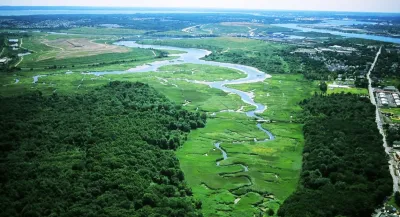Once the world’s largest dump, Freshkills Park now offers new city park space and powers local households with biofuel.

Last weekend marked a key moment in the transformation of “the world’s largest dump” into a public park with the opening of North Park in Staten Island’s Freshkills Park, writes Leslie Kaufman in Bloomberg Green.
The former landfill, which at its high point received 29,000 tons of trash daily, has been undergoing restoration since it was shut down by the city in 2001.
As Kaufman explains, the process of making a landfill site safe is complex. “Garbage compacts, creating shifting surface conditions. In North Park, the trash has been sculpted into four hills arranged around a tidal creek open for kayaking. There are roughly six layers of soil, sand and plastic lining on top of the garbage to prevent toxic leaks, including a vent layer, which moves any escaping landfill gas—a combination of carbon dioxide and methane—into pipes.”
Around the United States, over 500 landfills have been converted to energy projects that convert methane and other gases to fuel, and Freshkills is one of them. “The city sells 1.5 million cubic feet of this treated biogas to the local utility, which distributes it to Staten Island homes for cooking and heating.”
FULL STORY: How New York City Turned the World’s Biggest Garbage Dump Into a Park

National Parks Layoffs Will Cause Communities to Lose Billions
Thousands of essential park workers were laid off this week, just before the busy spring break season.

Retro-silient?: America’s First “Eco-burb,” The Woodlands Turns 50
A master-planned community north of Houston offers lessons on green infrastructure and resilient design, but falls short of its founder’s lofty affordability and walkability goals.

Delivering for America Plan Will Downgrade Mail Service in at Least 49.5 Percent of Zip Codes
Republican and Democrat lawmakers criticize the plan for its disproportionate negative impact on rural communities.

Test News Post 1
This is a summary

Test News Headline 46
Test for the image on the front page.

Balancing Bombs and Butterflies: How the National Guard Protects a Rare Species
The National Guard at Fort Indiantown Gap uses GIS technology and land management strategies to balance military training with conservation efforts, ensuring the survival of the rare eastern regal fritillary butterfly.
Urban Design for Planners 1: Software Tools
This six-course series explores essential urban design concepts using open source software and equips planners with the tools they need to participate fully in the urban design process.
Planning for Universal Design
Learn the tools for implementing Universal Design in planning regulations.
EMC Planning Group, Inc.
Planetizen
Planetizen
Mpact (formerly Rail~Volution)
Great Falls Development Authority, Inc.
HUDs Office of Policy Development and Research
NYU Wagner Graduate School of Public Service




























